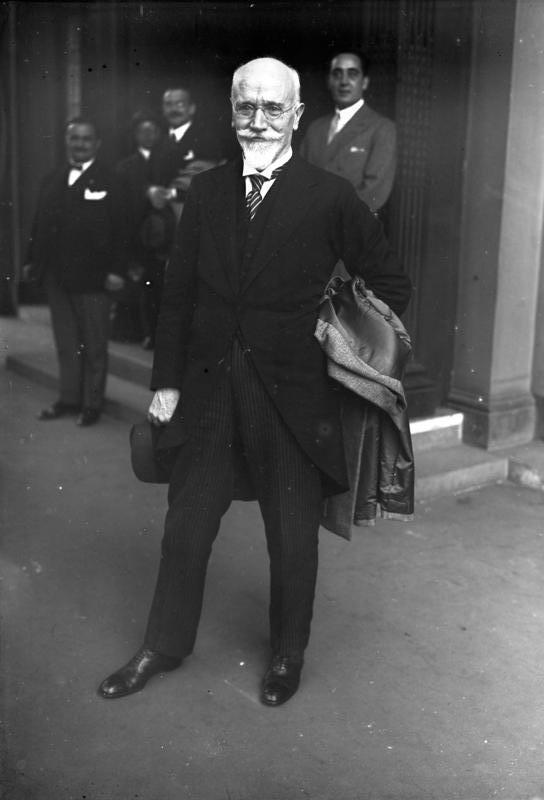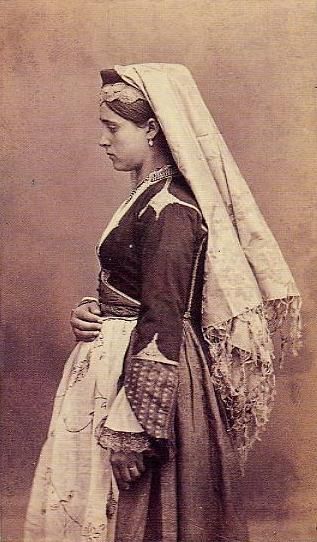
(Photo by www.alamy.de)
Cretan traditional costume was of the most elegant and most complicated form of clothing and was divided into everyday and festive clothing.
While in other regions traditional clothing was one of the first things to be replaced by western clothing named “frágkika roúha” – in Crete traditional clothing is worn up until today.
The culture of every place is the way to remember the roots of the population who lives in a particular place. Even in our community, this particular subject is so important because the culture is always mixed with our history and our tradition.
About the History of the Cretan traditional uniform there are many different stories, in reality the truth is that this particular uniform comes from the one that was worn form the resistors Cretans at the liberation wars 1821 – 1898 against the ottomans during the revolution period of 1866-1898.

(Photo by commons.org)
Some people back in the days they claimed that the first person who worn the folklore costume was the Prime Minister of Greece Eleftherios Venizelos (1864 – 1936) and some others stated that the first ones was the immigration team of the United States. None of the above stories presenting the truth and both of them was only theories as Prime Minister Eleftherios Venizelos as you can see at the above picture he is not wearing folklore costume, in some occasions he just preferred to put his trousers inside the leather boots .The immigrants never worn folklore costume when they returned back to United States, but only their traditional uniform which was a simple knee trouser.

(Photo by gr.pinterest.com)
In Crete after the liberation from the Ottomans in 1898 the Cretans established the traditional uniform.It was forbidden for them to wear this kind of fabric or colors before 1821 as the uniform was worn only by the police and the postmens of the Cretan state in 1898-1913. The idea of the uniform was inspired from the well-dressed resistor captains of Crete during the liberation of Crete in 1821 – 1898.In 1913 the Crete became part of the rest of the Greece and then the traditional clothing has been replaced from the European traditional uniform which during the German occupation it was established to be worn in dark tops and beige color trousers in an indication of mourn for the conquest of Crete from the Germans and the Italians for the thousand deaths for the honor of the country.
When Crete became an independent state in 1898 Cretans generated the named «The Cretan postal service ».Cretan postal services extend the Cretan postal stamps and create in total 35 permanent postal offices.As you can see in the above picture in the period of 1898 the folklore costume was worn from the postmens.

(Photo by www.macedonian-heritage.gr)
As we already mention the folklore costume was worn from the police officers at the same period. The Cretan police team was an armed team that was founded in 1899 and merged with the Greek Royal Gendarmerie in 1913, but it did not change its uniform after the Balkan Wars, In particular, in 1898 it has been generated the Cretan State based in Chania and with the High Commissioner.This Team has been created in order to submit the enforcementmostly between the Cretans and the Turks.
In Crete, the traditional women’s clothing was always varied and beautiful, already at the beginning of 19th century it has been changed. However at the villages and in the city the Cretan women still wearing the folklore costume which has been made from cotton material, the well-dressed costume which they used to wear at special occasions has been made from wool. Also they use to wear a long scarf to cover their hair. Those clothing used to be worn from ordinary womens with the exception of the older ones who was dressed up in black colors. In the winter time they used a cloak to cover their back from the cold and common black shoes or black leather boots e.g. stivania.The Cretan womens kept the traditional clothing and accessories till the 1920 were the European dress code has been take place.The ordinary womens prefer to wear simple day dresses, the womens who they owned expensive accessories and cloths they preferred to use them only for special occasions like weddings. it’s worth of mention the fact that those dresses has been converted in the time even because of a damage or to have a new appearance as it was a very expensive purchase for them. As the ordinary womens couldn’t have as many dresses as they want because of the expensive materials they worn an apron to protect their dresses and they used to embroidering designs to make them look unique.
(Photo by www.pinterest.com)



(photo by http://www.destinationcrete.gr )
Up to today the famous Cretan costume is still worn in several villages as men’s everyday wear, as well as being worn as formal wear by men and women on the occasion of traditional celebrations and in the villages they still use it us the costume for the groom and the bride.
Subscribe to our newsletter to receive the latest travel tips, destination insights, and exclusive offers directly to your inbox!
Take our fun and quick quiz to discover the perfect tour that aligns with your unique interests and desires. Whether you’re a history enthusiast, a foodie, an adventurer, or simply seeking relaxation, our personalized recommendations will ensure your journey matches your preferences. Take the quiz now and embark on the experience of a lifetime!

Subscribe now and get instant FREE Access to Unpublished Hand-picked Deals!

©2024 GS Tours. All Rights Reserved. Website by: Inglelandi Digital Agency
